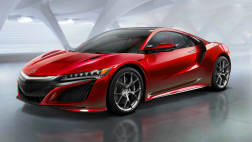Chinese buyers helped Bentley survive the downturn, which hit top-tier marques especially hard. Bentleys are large, which suits Chinese luxury tastes. Its bestseller there, by far, is the Flying Spur sedan.
The Flying Spur is the four-door variant of the Continental GT, the coupe that was the first car Bentley made after it split from Rolls-Royce to become part of the Volkswagen group.
The Continental GT defined the reborn Bentley. It was exactly the sort of eye-catching shape Bentley needed to put it back on the radar.
Eight years later the second-generation GT has arrived to carry the banner into the next decade.
DESIGN
Bentley desperately needs to boost sales but decided on a gentle evolution of the GT rather than a radical overhaul.
So there are subtle changes to make it look racier and more upmarket. It's wider than before and the waistline -- the lower edge of the windows -- has been raised. Some of the panels are now aluminium, which helps to shed about 60kg. It also means Bentley can use a shaping technique called superforming to avoid seams around the headlights, give crisper lines along the sides and more pronounced haunches.
TECHNOLOGY
Underneath, the suspension has been retuned while under the bonnet, the W-shaped 6.0-litre turbocharged 12-cylinder engine has got 11kW more power and 50Nm more torque. The all-wheel drive system now distributes drive with a 60 per cent bias to the rear instead of an even split, so that the dynamics more closely resemble a traditional sportscar.
Inside, Bentley has liberated some rear leg-room by redesigning the seats and relocating the seatbelts. The central control screen is larger and its software has received the latest upgrade.
DRIVING
THE previous Continental GT was a lovely car that epitomised the grand-tourer idea. This is a romantic notion, to me at least, that suggests effortless meandering among the cultural landmarks of Europe like an Evelyn Waugh character, a wad of inherited money in my back pocket.
Unhappily, that's not my lot and neither would it be for most GT owners. But the GT was a pleasant way to drive to work when you're a time-poor merchant bank exec. As a statement of weighty prosperity and power, the GT felt exactly like a Bentley should.
A design this good deserves to live beyond a single model cycle, especially at the top of the market. Some brands tinker with the same shape for decades without doing much; Porsche's 911 is exhibit A. There are sound reasons for Bentley to do the same. Inspired by famous models from its past, the face of the GT set Bentley on a design course that is still being followed.
Count the retained looks as a plus, but it's still doubtful whether Bentley has done enough with this upgrade.
Some changes play on our subconscious awareness of quality, giving the overall result a more polished feel. These include the way the headlights now sit in individual cut-outs, instead of the cheaper construction method used before. But other makers such as Morgan and Aston Martin already do this on cars that cost much less.
Some improvements, such as the new control screen in the centre console, aim to make it more modern. This system has been inherited from the Volkswagen group, then tweaked for the GT. But it's neither cutting-edge nor especially easy to use, and certainly not up there with the best. You don't come away thinking, “Oh, I wish my iPhone worked like that.'' It's worthwhile addressing these issues, but they're not a huge leap forward.
This is true of the engineering as well. The engine can run on ethanol up to E85 but has yet to gain direct injection, which improves fuel economy and power at the same time. This should arrive in a 4.0-litre V8, reportedly being developed with Audi, and due in the GT later this year.
This 12-cylinder, driving through an automatic transmission with six speeds as before, gains a little power and remains a muscular slurper. There's good torque from low revs for effortless progress, although snap acceleration is hampered somewhat by the GT's substantial mass. The weight shed in this upgrade is tiny compared with the car's mass and affects fuel consumption barely a jot. As you would expect, it feels solidly planted on the road and rides with heavyweight assurance. Despite the heft, there's some delicacy to the chassis, with body roll and pitch sweetly damped. It was, and remains, an enjoyable drive.
For anyone willing to spend $400,000 to $500,000 on a car, choices have multiplied since the GT arrived in 2003. Bentley says this vindicates its original strategy. But it also suggests that a minimalist approach to this upgrade may not be enough. If you didn't like the look of the original GT, the second generation won't change your mind.
BENTLEY CONTINENTAL GT
Engine: 6.0-litre turbocharged petrol 12-cylinder
Power/torque: 423kW at 6000rpm and 700Nm at 1700rpm
Transmissions: Six-speed automatic, all-wheel drive
Price: From $405,000 plus on-road costs
Bentley Continental 2011: GT
| Engine Type | W12, 6.0L |
|---|---|
| Fuel Type | Premium Unleaded Petrol |
| Fuel Efficiency | 17.1L/100km (combined) |
| Seating | 4 |
| Price From | $88,330 - $101,530 |







.jpg)

